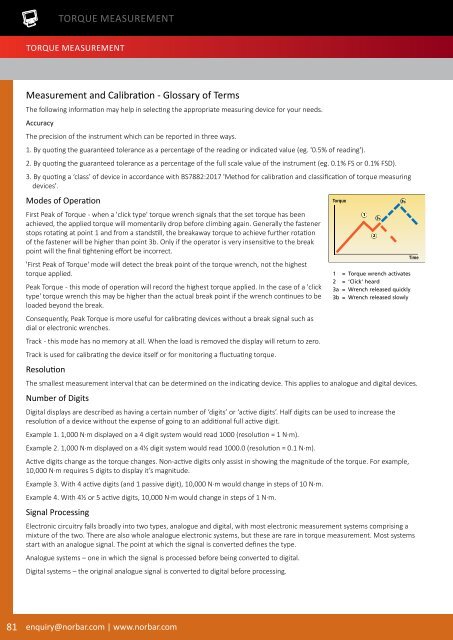Norbar Catalogue 2019
Create successful ePaper yourself
Turn your PDF publications into a flip-book with our unique Google optimized e-Paper software.
TORQUE MEASUREMENT<br />
TORQUE MEASUREMENT<br />
Measurement and Calibration - Glossary of Terms<br />
The following information may help in selecting the appropriate measuring device for your needs.<br />
Accuracy<br />
The precision of the instrument which can be reported in three ways.<br />
1. By quoting the guaranteed tolerance as a percentage of the reading or indicated value (eg. '0.5% of reading').<br />
2. By quoting the guaranteed tolerance as a percentage of the full scale value of the instrument (eg. 0.1% FS or 0.1% FSD).<br />
3. By quoting a ‘class’ of device in accordance with BS7882:2017 'Method for calibration and classification of torque measuring<br />
devices'.<br />
Modes of Operation<br />
First Peak of Torque - when a 'click type' torque wrench signals that the set torque has been<br />
achieved, the applied torque will momentarily drop before climbing again. Generally the fastener<br />
stops rotating at point 1 and from a standstill, the breakaway torque to achieve further rotation<br />
of the fastener will be higher than point 3b. Only if the operator is very insensitive to the break<br />
point will the final tightening effort be incorrect.<br />
'First Peak of Torque' mode will detect the break point of the torque wrench, not the highest<br />
torque applied.<br />
Peak Torque - this mode of operation will record the highest torque applied. In the case of a 'click<br />
type' torque wrench this may be higher than the actual break point if the wrench continues to be<br />
loaded beyond the break.<br />
Consequently, Peak Torque is more useful for calibrating devices without a break signal such as<br />
dial or electronic wrenches.<br />
Track - this mode has no memory at all. When the load is removed the display will return to zero.<br />
Track is used for calibrating the device itself or for monitoring a fluctuating torque.<br />
Resolution<br />
The smallest measurement interval that can be determined on the indicating device. This applies to analogue and digital devices.<br />
Number of Digits<br />
Digital displays are described as having a certain number of ‘digits’ or ‘active digits’. Half digits can be used to increase the<br />
resolution of a device without the expense of going to an additional full active digit.<br />
Example 1. 1,000 N·m displayed on a 4 digit system would read 1000 (resolution = 1 N·m).<br />
Example 2. 1,000 N·m displayed on a 4½ digit system would read 1000.0 (resolution = 0.1 N·m).<br />
Active digits change as the torque changes. Non-active digits only assist in showing the magnitude of the torque. For example,<br />
10,000 N·m requires 5 digits to display it’s magnitude.<br />
Example 3. With 4 active digits (and 1 passive digit), 10,000 N·m would change in steps of 10 N·m.<br />
Example 4. With 4½ or 5 active digits, 10,000 N·m would change in steps of 1 N·m.<br />
Signal Processing<br />
Electronic circuitry falls broadly into two types, analogue and digital, with most electronic measurement systems comprising a<br />
mixture of the two. There are also whole analogue electronic systems, but these are rare in torque measurement. Most systems<br />
start with an analogue signal. The point at which the signal is converted defines the type.<br />
Analogue systems – one in which the signal is processed before being converted to digital.<br />
Digital systems – the original analogue signal is converted to digital before processing.<br />
81 enquiry@norbar.com | www.norbar.com







